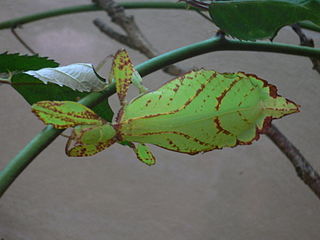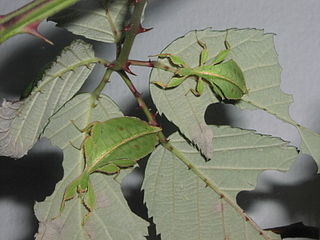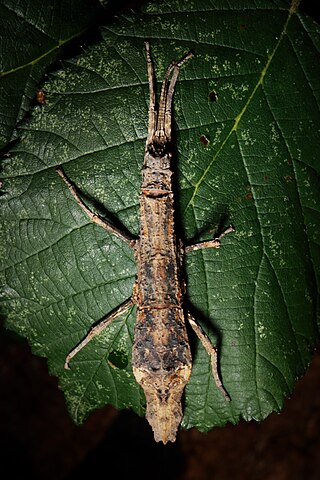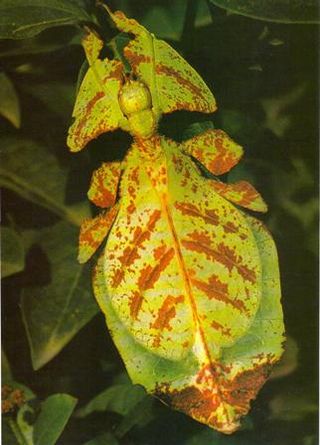
The family Phylliidae contains the extant true leaf insects or walking leaves, which include some of the most remarkably camouflaged leaf mimics (mimesis) in the entire animal kingdom. They occur from South Asia through Southeast Asia to Australia. Earlier sources treat Phylliidae as a much larger taxon, containing genera in what are presently considered to be several different families.

Phyllium is the largest and most widespread genus of leaf insects in the family Phylliidae (Phasmatodea). They can be found in Sundaland, Philippine Islands, Wallacea, and Australasia.

Cryptophyllium westwoodii is a species of leaf insect in the family Phylliidae. It is distributed from southern China, the Andaman islands, Myanmar, Indo-China, Sumatra and the Riouw Archipelago.

Pylaemenes is a genus of stick insects in the family Heteropterygidae and subfamily Dataminae. It combines small to medium-sized, often brightly colored Phasmatodea species. Their representatives are found in large parts of Southeast Asia.

The genus Orestes combines relatively small and elongated Phasmatodea species from Southeast and East Asia.

Orestes draegeri is a species of stick insects in the subfamily Dataminae and tribe Datamini.

Cryptophyllium celebicum, simply known as walking leaf mimic insect, is type species of leaf insect in the new (2021) genus Cryptophyllium, which has been placed the tribe Phylliini. Its recorded distribution is Sulawesi and Ambon Island.

Datamini is the only tribe within the subfamily of the Dataminae from the order of the Phasmatodea. The representatives of this subfamily are on average not as large as those of the other two subfamilies belonging to the family of Heteropterygidae.

The genus Dares, which is mainly native to Borneo, combines relatively small and mostly dark-colored Phasmatodea species.

The genus Microrestes combines relatively small and squat Phasmatodea species from continental Southeast Asia and South China.

Orestes dittmari is a species of stick insects in the subfamily Dataminae.

Orestes bachmaensis is a Phasmatodea species native to central Vietnam.

Orestes japonicus, a stick insect, is a representative of the genus Orestes.

Orestes krijnsi is a species of stick insects native to Vietnam.

Orestes subcylindricus is a species of stick insects native to Vietnam.

Pylaemenes elenamikhailorum is a species of stick insects native in Sepilok on Borneo. In application of the more recent differentiation between the genera Pylaemenes and Orestes the species is sometimes also called Orestes elenamikhailorum.
Pylaemenes konkakinhensis is a species of stick insects native in Vietnam. The species is so far only known from a single female.

Pulchriphyllium is a genus of leaf insects. It was first established by Griffini in 1898 as a subgenus within the genus Phyllium and is a valid genus since 2021. The distinctive feature of Pulchriphyllium is the presence of lobes on the inside and outside of the fore tibia. In Phyllium are lobes only present on the outside. The representatives of the genus are native to both Sundaland and continental Asia.

Haaniella gorochovi is a stick insect species from Vietnam. It is a typical representative of the subfamily Heteropteryginae. The occasionally used common name Gorochov’s Haaniella refers to the species name.

Pylaemenes konchurangensis is a species of stick insects native in Vietnam. The species has been described in the genus Pylaemenes, but from its morphological characters it belongs in the genus Orestes.




















